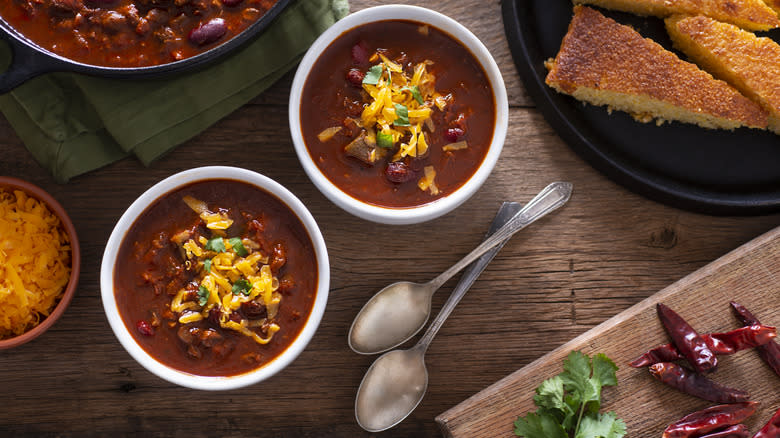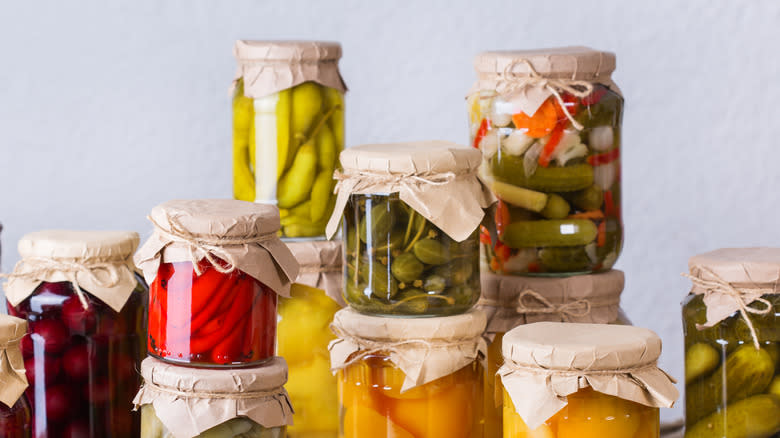Pepperoncinis Are The Slept-On Ingredient For More Robust Chili

Pepperoncinis can add a tangy crunch to pizza, sandwiches, wraps, pasta, and Mediterranean salads. But have you ever tried them in your chili? While jalapeño peppers often crank up a chili's heat, pepperoncinis are mild peppers that can boost the flavor of bland chili without making your eyes water. Pickled pepperoncinis, in particular, are perfect for adding a flavor that pairs well with chili's spices.
To incorporate pepperoncinis into your own recipe, slice up one or two fresh peppers and toss them in the pot while it cooks so that the chili is infused with the peppery flavor. If you want, you can garnish your bowl with a few extra pieces to add some crunch to each spoonful of chili.
If you really want a boost of savory flavor, incorporate some jarred pickled pepperoncinis from the grocery store. Alternatively, you can make your own pickled pepperoncinis by soaking the peppers in a brine consisting of mainly vinegar, sugar, water, and salt. In addition to the peppers, add some of the briny liquid from the jar to your chili for extra tangy flavor.
Read more: 14 Liquids To Add To Scrambled Eggs (And What They Do)
Just How Spicy Are Pepperoncinis?

While pickled pepperoncinis (not to be confused with banana peppers) can seriously elevate your chili, you shouldn't expect them to add too much heat. If you want something with more of a kick, opt for jalapeños or other hot chili peppers instead. Pepperoncinis hardly register on the Scoville scale (a scale for measuring the spiciness of peppers and hot sauces), coming in at just 100 to 500 Scoville Heat Units (SHU). In comparison to a bell pepper, a pepperoncino is just a little higher on the scale. But it's way below a jalapeño, which ranges from 2,500 to 8,000 SHU. If you like spiciness in your chili, you can always add multiple types of peppers.
If you don't tolerate spicy food well in general, keep in mind that pepperoncinis do have a hint of spiciness, so you might opt for adding just a few to your chili. Alternatively, use pickled pepperoncinis, since the pickling process tames some of the spiciness while enhancing the flavor of the peppers.
You Can Easily Pickle Peppers At Home

You could buy a jar of pickled pepperoncinis from the store, or you can channel your inner Peter Piper and easily pickle your peppers at home. To pickle the perfect peppers to please your palate, you'll need fresh pepperoncinis, which you can get from the grocery store, farmer's market, or better yet, your own garden if you plan ahead. When picking the peppers, look for ones that are bright in color, firm, and smooth with no dark spots.
To make the brine you'll need vinegar, water, sugar, pickling salt, garlic, and herbs and spices like bay leaves and black peppercorns. One useful tip is to make a small cut in the peppers before placing them in the jar so that the brine can effectively saturate the entire pepper. The peppers should soak in the brine for at least three days in the refrigerator, but you can soak them longer for a stronger vinegar flavor. The pepperoncinis will stay good in the refrigerator for several months so you'll always have some on hand for your chili, salads, pizza, pasta, and whatever other dish you want to add a tangy crunch to.
Read the original article on Daily Meal.

